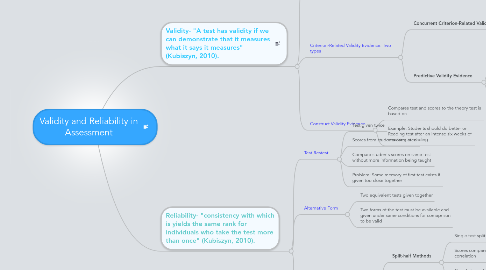
1. Validity- "A test has validity if we can demonstrate that it measures what it says it measures" (Kubiszyn, 2010).
1.1. Content Validity Evidence
1.1.1. Done by inspecting test question
1.1.2. Shows whether test evaluates the appropriate subject matter
1.1.3. Only evaluates content and whether test appears valid
1.2. Criterion-Related Validity Evidence: Two types
1.2.1. Concurrent Criterion-Related Validity Eivdence
1.2.1.1. Yields a numeric value to be used for comparison
1.2.1.2. Used to find correlation between test scores
1.2.1.3. Shows how new test compare to previous versions
1.2.2. Predictive Validity Evidence
1.2.2.1. Predicts how well students will do in the future
1.2.2.2. Example: SAT, ACT for admittance into college
1.2.2.3. Scores are compared to how students actually do in the future
1.3. Construct Validity Evidence
1.3.1. Compares test and scores to the theory test is based on
1.3.2. Example: Students should do better on Reading test after an intense six weeks of coaching in reading
2. Reliability- "consistency with which is yields the same rank for individuals who take the test more than once" (Kubiszyn, 2010).
2.1. Test-Restest
2.1.1. Test given twice
2.1.2. Scores from students correlated
2.1.3. Compare students scores on same test without more information being taught
2.1.4. Problem: Some memory of first test exists if given too close together
2.2. Alternative Form
2.2.1. Two equivalent tests given together
2.2.2. Two forms of the test must be available and given under same conditions for comaprison to be valid
2.3. Internal Consistency: Two Types
2.3.1. Split-half Methods
2.3.1.1. Single test split in half
2.3.1.2. Scores compared from halves to see correlation
2.3.1.3. Correlation calculated by Spearman-Brown prophecy formula
2.3.2. Kuder-Richardson methods
2.3.2.1. Compare questions with common subject matter
2.3.2.2. Test must be for a single subject matter for analysis to be valid
2.3.2.3. Uses KR20 or KR21
